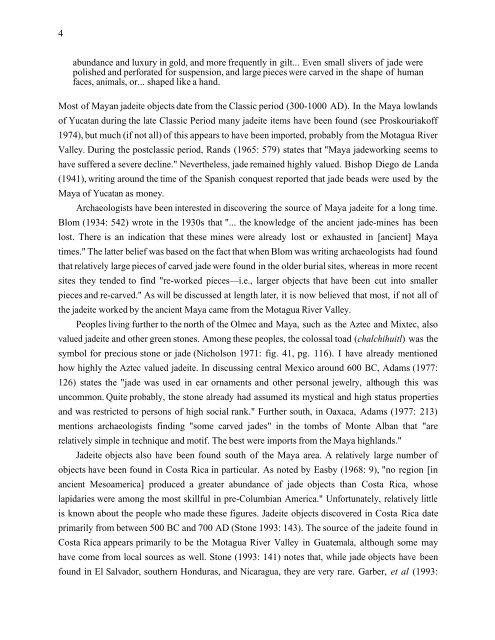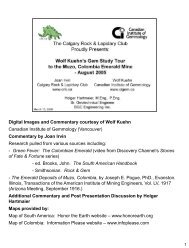JADEITE - Canadian Institute of Gemmology
JADEITE - Canadian Institute of Gemmology
JADEITE - Canadian Institute of Gemmology
Create successful ePaper yourself
Turn your PDF publications into a flip-book with our unique Google optimized e-Paper software.
4<br />
abundance and luxury in gold, and more frequently in gilt... Even small slivers <strong>of</strong> jade were<br />
polished and perforated for suspension, and large pieces were carved in the shape <strong>of</strong> human<br />
faces, animals, or... shaped like a hand.<br />
Most <strong>of</strong> Mayan jadeite objects date from the Classic period (300-1000 AD). In the Maya lowlands<br />
<strong>of</strong> Yucatan during the late Classic Period many jadeite items have been found (see Proskouriak<strong>of</strong>f<br />
1974), but much (if not all) <strong>of</strong> this appears to have been imported, probably from the Motagua River<br />
Valley. During the postclassic period, Rands (1965: 579) states that "Maya jadeworking seems to<br />
have suffered a severe decline." Nevertheless, jade remained highly valued. Bishop Diego de Landa<br />
(1941), writing around the time <strong>of</strong> the Spanish conquest reported that jade beads were used by the<br />
Maya <strong>of</strong> Yucatan as money.<br />
Archaeologists have been interested in discovering the source <strong>of</strong> Maya jadeite for a long time.<br />
Blom (1934: 542) wrote in the 1930s that "... the knowledge <strong>of</strong> the ancient jade-mines has been<br />
lost. There is an indication that these mines were already lost or exhausted in [ancient] Maya<br />
times." The latter belief was based on the fact that when Blom was writing archaeologists had found<br />
that relatively large pieces <strong>of</strong> carved jade were found in the older burial sites, whereas in more recent<br />
sites they tended to find "re-worked pieces—i.e., larger objects that have been cut into smaller<br />
pieces and re-carved." As will be discussed at length later, it is now believed that most, if not all <strong>of</strong><br />
the jadeite worked by the ancient Maya came from the Motagua River Valley.<br />
Peoples living further to the north <strong>of</strong> the Olmec and Maya, such as the Aztec and Mixtec, also<br />
valued jadeite and other green stones. Among these peoples, the colossal toad (chalchihuitl) was the<br />
symbol for precious stone or jade (Nicholson 1971: fig. 41, pg. 116). I have already mentioned<br />
how highly the Aztec valued jadeite. In discussing central Mexico around 600 BC, Adams (1977:<br />
126) states the "jade was used in ear ornaments and other personal jewelry, although this was<br />
uncommon. Quite probably, the stone already had assumed its mystical and high status properties<br />
and was restricted to persons <strong>of</strong> high social rank." Further south, in Oaxaca, Adams (1977: 213)<br />
mentions archaeologists finding "some carved jades" in the tombs <strong>of</strong> Monte Alban that "are<br />
relatively simple in technique and motif. The best were imports from the Maya highlands."<br />
Jadeite objects also have been found south <strong>of</strong> the Maya area. A relatively large number <strong>of</strong><br />
objects have been found in Costa Rica in particular. As noted by Easby (1968: 9), "no region [in<br />
ancient Mesoamerica] produced a greater abundance <strong>of</strong> jade objects than Costa Rica, whose<br />
lapidaries were among the most skillful in pre-Columbian America." Unfortunately, relatively little<br />
is known about the people who made these figures. Jadeite objects discovered in Costa Rica date<br />
primarily from between 500 BC and 700 AD (Stone 1993: 143). The source <strong>of</strong> the jadeite found in<br />
Costa Rica appears primarily to be the Motagua River Valley in Guatemala, although some may<br />
have come from local sources as well. Stone (1993: 141) notes that, while jade objects have been<br />
found in El Salvador, southern Honduras, and Nicaragua, they are very rare. Garber, et al (1993:









